Hanoi is a city of contrasts, where modernity intertwines with deep-rooted tradition. Modernity lives on its busy streets, while memories of the past of Hanoi are preserved deep into the city’s narrow, winding alleys.
Writer and history researcher Thien Viet, a prizewinner at the 2024 Hanoi Memories Writing Contest who has traveled to cities all around the world, believes no other city has a maze of narrow alleys to compare with Hanoi’s.
Viet said: “The prevalence of these small alleys is tied to the city’s history. Hanoi has developed from numerous villages and communes that gradually urbanized. Each of these villages had numerous narrow alleys and lanes, which were formed over time. These villages were often established by farmers migrating from rural areas to Hanoi, forming communities based on their origins or professions. Often, people from the same village or those sharing a common trade would move together to the city.”
 Phat Loc Street is a place where tourists can find well-known noodle dishes that symbolize Hanoi (Photo: VOV5) Phat Loc Street is a place where tourists can find well-known noodle dishes that symbolize Hanoi (Photo: VOV5) |
Phat Loc alley is hidden in the heart of Hanoi’s Old Quarter, less than 100 meters from Hoan Kiem Lake. Most of the alley’s residents – or, at least, their ancestors – moved to the capital from a small village in the countryside in order to ‘change their life’. They consider themselves fortunate to be making a living now by running a business in this tiny alley.
Viet said: “Phat Loc alley, located next to Van Bac Street, was established by residents of Phat Loc village in Thai Binh province, who migrated to Hanoi in the 17th century. When they settled in Hanoi, they stayed together and preserved the name "Phat Loc", bringing it from Thai Binh and giving it to their alley.”
Phat Loc alley is a heaven for food lovers. The street food here includes bun cha (noodle with grilled pork), bun rieu cua (crab noodle soup), bun oc (snail noodle), and bun dau mam tom (noodle with fried tofu and shrimp paste). The alley also has several small temples and shrines of historical significance.
“Phat Loc Alley is quite unique and historic, featuring small temples like the shrine of Nguyen Trung Ngan, a renowned official of the Tran dynasty, which continued to be maintained into the 19th century. The alley was also the place where many officers of the Capital Regiment gathered for training in the 1940s to fight the French and defend the capital. This alley was the site of one of the major battles to protect Hanoi when French forces attacked the city,” said Viet.
Some alleys – like Thong Phong lane in Ton Duc Thang street, Dong Da district –started as craft villages. Viet said: “In the previous century, this was a craft village that specialized in glass-blowing for light bulbs, where the old term ‘Thong Phong’ referred to those bulbs. Over time, with urbanization, the village became Thong Phong alley. Some of the original families still live here, whose ancestors were the glass-blowers who created the Thong Phong light bulbs.”
Any discussion of the ancient alleys of Hanoi has to include Tam Thuong, an 800-meter-long alley just off Hang Bong street that is one of the oldest and most historic alleys in Hanoi. ‘Tam Thuong’ means ‘compassion’ or ‘kind-heartedness’.
Viet said: “Long ago it acquired the beautiful name “Tam Thuong,” though people today don’t really understand why it has such a lovely name. In fact, in previous centuries, its name was "Tram Thuong" (Tax Station), as it served as a place for the imperial court to collect taxes. Over time, the name changed to Tam Thuong.”
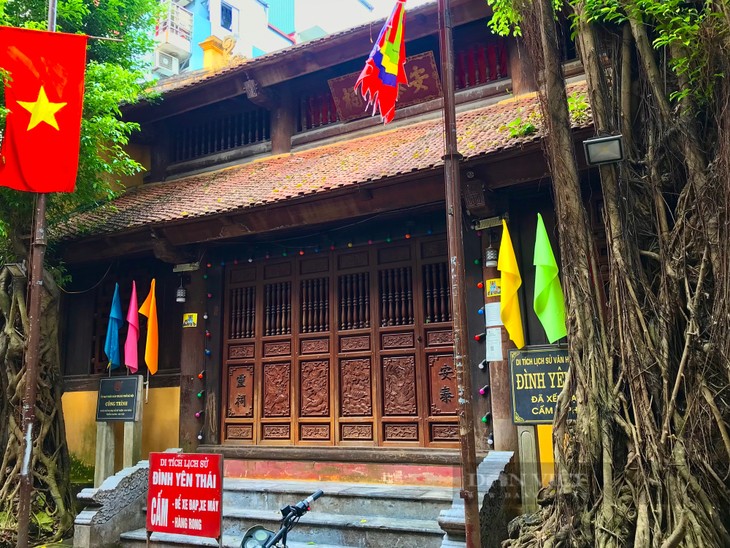 Yen Thai temple in Tam Thuong alley still holds reminiscent features of traditional Vietnamese villages (Photo: danviet.vn) Yen Thai temple in Tam Thuong alley still holds reminiscent features of traditional Vietnamese villages (Photo: danviet.vn) |
Long ago Tam Thuong alley began to draw dozens of eminent musicians, writers, poets, and artists and inspired many songs and poems that have touched the hearts of generations of Hanoians. Tam Thuong alley is still a magnet for visitors seeking nostalgic memories of old Hanoi.
“Now it has become a tourist destination. Because within it, you can still find images reminiscent of traditional Vietnamese villages, like banyan trees and ancient wells that have been preserved. One special aspect of these alleys is the close-knit relationships among the residents. Many came from the same village and practiced the same trade, so they hold one another in high regard and treat each other with kindness. If someone in the alley falls ill or faces hardship, the others will come to help. Each alley thus preserves the essence of village life within the heart of Hanoi,” Viet says.
Beyond its best-known alleys, Hanoi has many less famous alleys crowded into the heart of the Old Quarter. In these small alleys are families who have lived there for generations.
Walking along Hang Buom, Hang Ngang, Hang Dao, or Hang Bac street, you’ll pass the entrances to narrow alleys about 70 cm wide and only a couple of meters high. Some are so low you have to bend down to pass through them. Though they can be uncomfortably cozy, these tiny alleys are one of the things that make Hanoi's Old Quarter unique.
38-year-old Pham Xuan Hai showed us his living space in a tiny alley off Hang Bac street. “I live in a small alley at 32 Hang Bac street. The house was built during the French colonial period and later expanded by adding two additional floors. The ground floor was where my grandfather lived while the upper floors were for my uncle’s family,” said Hai.
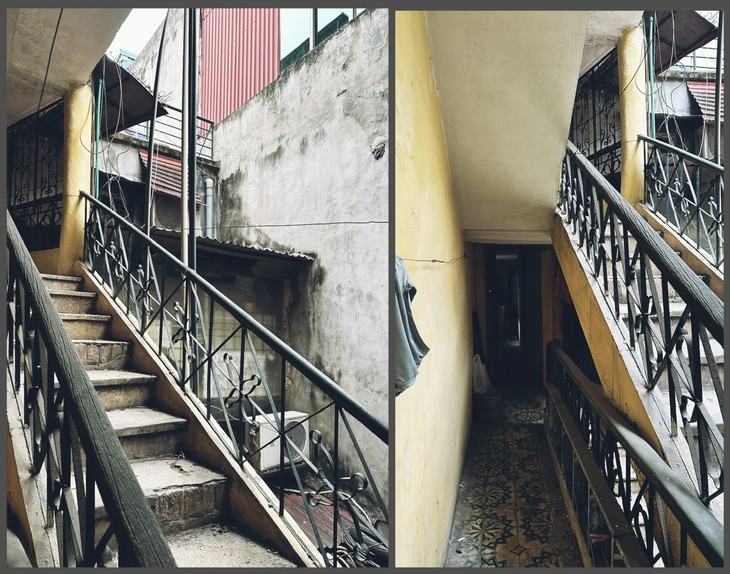 The interior of the alley retains its original structure (Photo: VOV5) The interior of the alley retains its original structure (Photo: VOV5) |
“Originally, it was just one home with an outer room, an inner room, a courtyard, and a kitchen. After some renovations, the layout has changed a bit to fit modern life better. We’ve divided it up. Usually, an address like this will cover 100–120 square meters.”
Six households live in rooms off the tunnel-like alley. Inside, you have to turn on a light to see anything, although a small courtyard lets in a bit of natural light. Each household has one room which serves as living room, bedroom, and kitchen. Several households share one toilet.
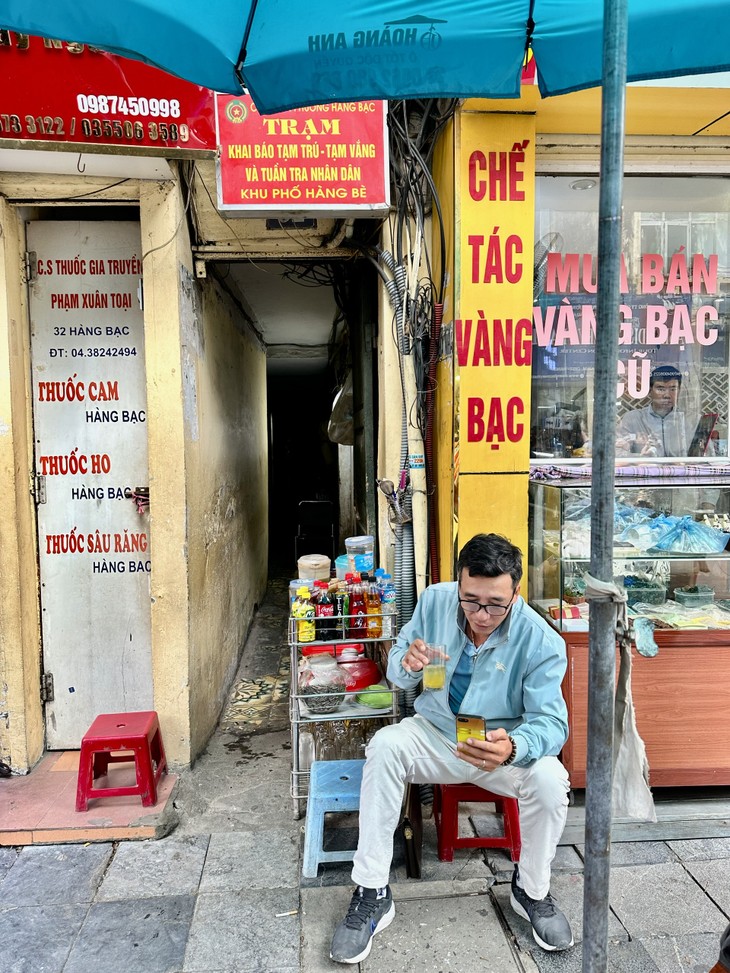 Sidewalk stalls, often run by local residents in Hanoi's Old Quarter (Photo: VOV5) Sidewalk stalls, often run by local residents in Hanoi's Old Quarter (Photo: VOV5) |
Although space is quite limited inside and outside these houses, the residents make the most of it to earn their living. They sell things from tiny stalls in or next to the alley. One of Hai’s uncles sells herbal medicines. Another sells tea and snacks.
Hai follows the family craft of silver making and sells what he makes at a 10-square-meter stall in front of the alley. Despite its inconveniences, Hai seems not to mind the living conditions in his alley. “Life here has some constraints on living space, but it has other conveniences, like access to services and cultural events around Hoan Kiem Lake. The home itself may be small, but stepping out into the street relieves the cramped feeling.
When several households share the same living space, disagreements and conflicts are inevitable, but since we’re all relatives, we find ways to resolve them. I’ve lived here since I was a kid, and if I were to move, I wouldn’t know where to go. My business and livelihood are here. If I left, I don’t know what I’d do for a living.”
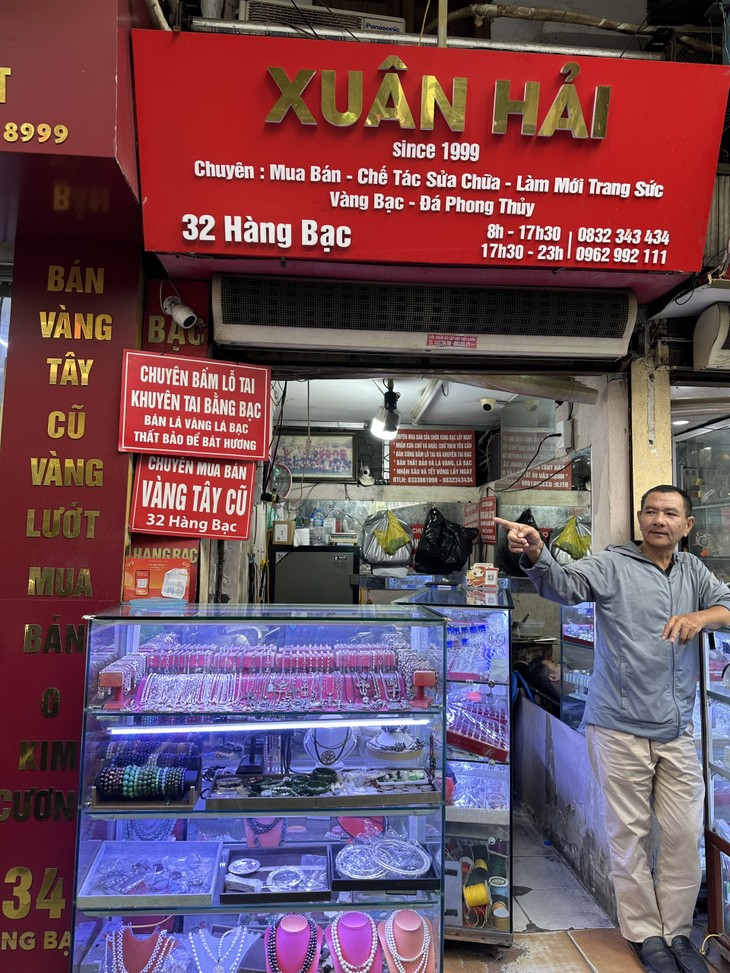 Hai follows his family’s silver making craft, selling his products in a small stall in front of the alley (Photo: VOV5) Hai follows his family’s silver making craft, selling his products in a small stall in front of the alley (Photo: VOV5) |
Mr. Pham Thong Tue, another resident of the Old Quarter, says the rapid development of Hanoi has brought changes to the small alleys, too.
Tue said: “It’s different now. There are some individual spaces. Each household has their own area, although 2 or 3 houses may share one bathroom. And the kitchen is also separate. Kitchens are different now. We don’t use firewood, straw, or coal anymore. Now we use gas or electric stoves. Residents are encouraged to follow safety regulations and the cultural lifestyle of Hanoians."
"Some nearby areas have been made into pedestrian streets which provides new opportunities for people to improve their incomes and participate in community activities. Our neighborhood has many cultural relic sites and temples which international organizations have begun to fund for preservation,” Tue added.
Although Hanoi has modernized, the small alleys still retain architectural features of old Hanoi, as well as the cultural lifestyle, occupational traditions, and other features that define the city. Mr. Tue said: “The importance of tradition can be clearly seen in the Old Quarter during Tet, the Lunar New Year. At Tet, people visit each other, regardless of their family circumstances, problems, or disputes. They still visit one another and exchange New Year wishes. Despite their cramped living space, family members still gather to exchange best wishes at holidays, ceremonies, and Tet.”
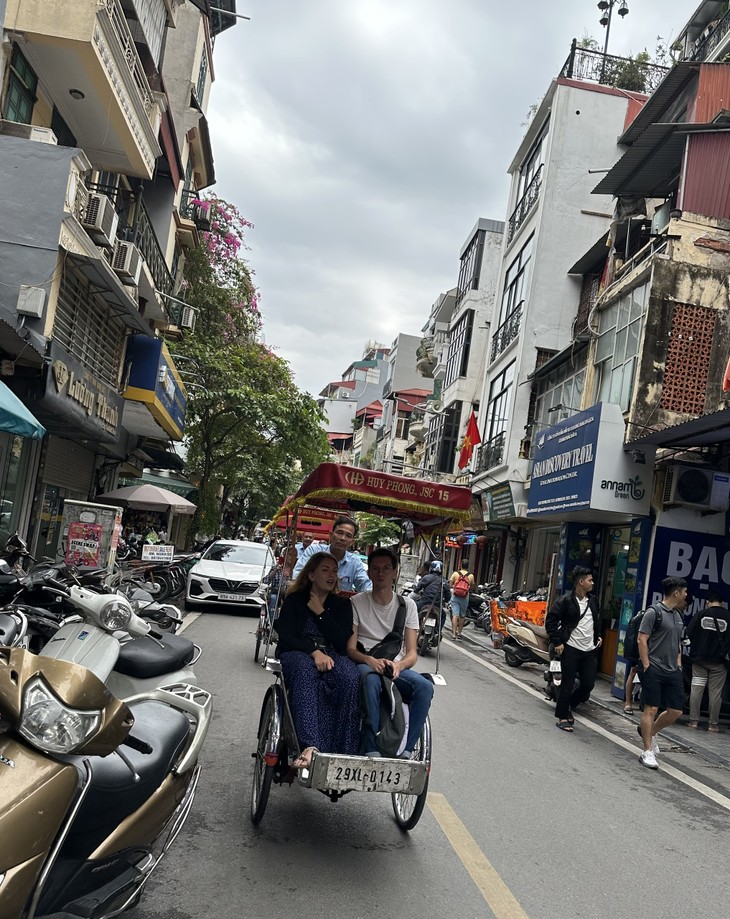 Many foreigners visit the Old Quarter to explore Hanoi's culture and tradition (Photo: VOV5) Many foreigners visit the Old Quarter to explore Hanoi's culture and tradition (Photo: VOV5) |
Many residents are tempted to sell their home to make way for larger commercial ventures. The pressure to expand and renovate has led to changes in the population of the Old Quarter.
Mr. Nguyen Tien Thang, former Secretary and Chairman of Hoan Kiem district’s People’s Committee, said: “The population of Hanoi’s Old Quarter has seen considerable changes. Many people have moved away to other places for the sake of their businesses or more comfortable living conditions. Only a few continue to live here. In my area, there used to be hundreds of households, but now there are only a few dozen left. The others have moved away. We’ve preserved the ancient houses. The local authorities have supported us in renovating while preserving the original architecture and historical features.”
The small alleys of Hanoi are an embodiment of the city’s distinct character, and year after year they continue to preserve the thousand-year-old culture of its people against the erosion of time.